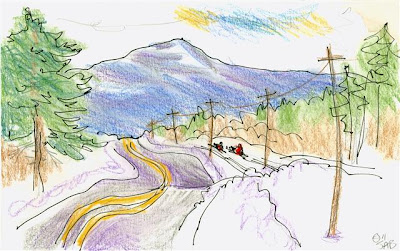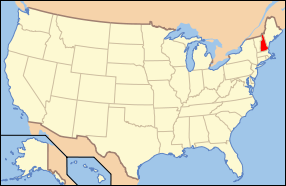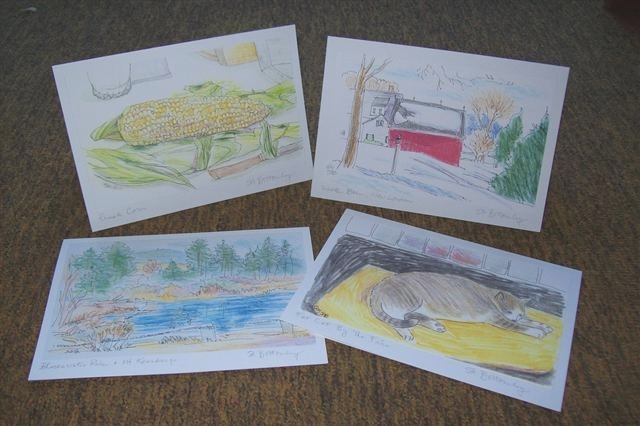 Here is my drawing of Dinner With Jack Frost on the New London town common last month. I drew in pencil by the light of a small reading light clipped to my paper. I added the color at home with colored pencils. It was dark, cold, snowy, and fun. The yellows are bonfires, torches, a street light, and the moon. The right shape is a tent with a live band, the rest are left to right the town hall and the band stand. Children are bundled up and pulled in sleds. Various restaurants offered great food in many locations.
Here is my drawing of Dinner With Jack Frost on the New London town common last month. I drew in pencil by the light of a small reading light clipped to my paper. I added the color at home with colored pencils. It was dark, cold, snowy, and fun. The yellows are bonfires, torches, a street light, and the moon. The right shape is a tent with a live band, the rest are left to right the town hall and the band stand. Children are bundled up and pulled in sleds. Various restaurants offered great food in many locations. 
This is me, with my small paper, and small light clipped to the paper. It was dark, but the flash of the camera makes it look quite bright.

And here is a 9” x 12” painting on canvas, based on the pencil drawing. I didn’t try to replicate the grey of the graphite pencil. The winter people were fun to paint, as all had big hands, heads, and feet.
 I did this drawing of the Theophilus Stanley Tavern (1791) in Hopkinton very rapidly, as it was extremely cold that day. Many houses in this area are painted white. I chose a yellow one to contrast with the enormous piles of snow along the road. The buildings are made of wood. Next to the tavern which is now a private residence is a nice corner market called the Cracker Barrel. The word cracker means salted biscuit in North America. In times past they were distributed in barrels. Empty barrels were used as tables, so the phrase ‘cracker barrel’ means a gathering place.
I did this drawing of the Theophilus Stanley Tavern (1791) in Hopkinton very rapidly, as it was extremely cold that day. Many houses in this area are painted white. I chose a yellow one to contrast with the enormous piles of snow along the road. The buildings are made of wood. Next to the tavern which is now a private residence is a nice corner market called the Cracker Barrel. The word cracker means salted biscuit in North America. In times past they were distributed in barrels. Empty barrels were used as tables, so the phrase ‘cracker barrel’ means a gathering place.  After I finished a session as Picture Person in the nearby elementary school (ages 5-10), I stopped here for a coffee. The large multi-paned window offered many views of the world. I like to see red berries in the winter. For birds, they are freeze-dried snacks.
After I finished a session as Picture Person in the nearby elementary school (ages 5-10), I stopped here for a coffee. The large multi-paned window offered many views of the world. I like to see red berries in the winter. For birds, they are freeze-dried snacks.Picture Person is a program of art history, presented as a supplement to the regular curriculum. Right now I meet with a class of seven year olds once a month. We have fun, discussing lofty topics, then drawing. This month, the subject is John James Audubon.
 Here we have our front hall. My husband had left early this day while I was still in bed. He kindly left a sign for me. Our house, built in 1972, has lots of glass. The door is all glass and to the left is a floor to ceiling window. The snow shovel is waiting out on the small porch. The snow has drifted over his footprints.
Here we have our front hall. My husband had left early this day while I was still in bed. He kindly left a sign for me. Our house, built in 1972, has lots of glass. The door is all glass and to the left is a floor to ceiling window. The snow shovel is waiting out on the small porch. The snow has drifted over his footprints. Some days, in a northern climate, you just have to buy a flowering plant for your table. The blue lines behind the plant are icicles hanging from the roof outside the picture window.
Some days, in a northern climate, you just have to buy a flowering plant for your table. The blue lines behind the plant are icicles hanging from the roof outside the picture window. This is the view on a cold February day of the old cotton mill in Newmarket. The mill building now houses small businesses and private residences. New Hampshire has a long history of mills and manufacturing, based on water power. The mills closed, lay empty for years, and are now coming back to life, in new forms. The coffee shop, Crackskull's Coffee & Books, has an amazing array of items adorning their walls. Old typewriters, and musical instruments for example. The selection of second-hand books is fine too.
This is the view on a cold February day of the old cotton mill in Newmarket. The mill building now houses small businesses and private residences. New Hampshire has a long history of mills and manufacturing, based on water power. The mills closed, lay empty for years, and are now coming back to life, in new forms. The coffee shop, Crackskull's Coffee & Books, has an amazing array of items adorning their walls. Old typewriters, and musical instruments for example. The selection of second-hand books is fine too.
The snow shovel, next to the glass door, awaits the next storm.
 I was driving around one day looking for something to draw. I went farther afield than usual, to Canaan near Hanover. I didn’t feel inspired and turned the car around, preparing to return to New London. When I did so, I immediately saw this peak, Mount Cardigan, and was taken by it. Just when I had finished drawing, the two people on snow mobiles zoomed out of the woods and into my art.
I was driving around one day looking for something to draw. I went farther afield than usual, to Canaan near Hanover. I didn’t feel inspired and turned the car around, preparing to return to New London. When I did so, I immediately saw this peak, Mount Cardigan, and was taken by it. Just when I had finished drawing, the two people on snow mobiles zoomed out of the woods and into my art. I was standing in the street to draw this. In New London, at the corner of Main Street and Pleasant Street, at the blinking light. We are looking at Mount Sunapee, in the nearby town of Newbury. Clearly, it has a ski resort on its slopes. The road was a challenge to draw, as it is roller-coaster in feel and goes way downhill, then uphill and ends at a t-junction. There are houses hidden by the trees. This mountain view is seen from all over town, along with Mount Kearsarge farther east. In the summer time, the ski slopes are green with grass.
I was standing in the street to draw this. In New London, at the corner of Main Street and Pleasant Street, at the blinking light. We are looking at Mount Sunapee, in the nearby town of Newbury. Clearly, it has a ski resort on its slopes. The road was a challenge to draw, as it is roller-coaster in feel and goes way downhill, then uphill and ends at a t-junction. There are houses hidden by the trees. This mountain view is seen from all over town, along with Mount Kearsarge farther east. In the summer time, the ski slopes are green with grass. One more snowy picture. Here is the view from our upstairs bedroom window. As you can see, our house backs up to a very steep hill. At the top of the hill is an old stone wall, which does indeed constitute that edge of our property. This means sheep were grazed on this very steep hill at one time, in the early 1830’s.
One more snowy picture. Here is the view from our upstairs bedroom window. As you can see, our house backs up to a very steep hill. At the top of the hill is an old stone wall, which does indeed constitute that edge of our property. This means sheep were grazed on this very steep hill at one time, in the early 1830’s.Hard to believe, because of the pitch of the hill, the rockiness, and the fact that the land is completely reforested. There was a sheep boom and bust in this area in the early 1800’s. After the Civil War ended, the area lost half its population. Not through death of soldiers, but by young farmers heading to the mid-west (like Ohio) for an easier farming life. New England life stagnated for a hundred years. I read that in our town, there were almost no homes built between 1840-1940. Which is why it looks appealing now—a harmony of architecture.
I do love the way snow conceals objects. And reveals secrets not seen in the summer.





No comments:
Post a Comment